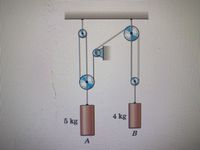Question
1. At time t = 0, the velocity of cylinder A is 0.3 m/s
down. By the methods of this article, determine the
velocity of cylinder B at time t = 2 s. Assume no
mechanical interference and neglect all friction.
please explain how :(

Transcribed Image Text:4 kg
5 kg
B.
Expert Solution
This question has been solved!
Explore an expertly crafted, step-by-step solution for a thorough understanding of key concepts.
Step by stepSolved in 2 steps

Knowledge Booster
Similar questions
- A bicyclist is at the bottom of a hill with a speed of 30 ft/s. After traveling 600 ft on the road, she reaches the top of the hill with a speed of 15 ft/s. Her total acceleration at the top of the hill is 1.3 ft/s^2. Assuming her acceleration along the road is constant. -What is the radius of curvature for the top of the hill?arrow_forwardA record is played by spinning the record so that a circular groove in the vinyl slides under the stylus. Suppose that a record turns at a rate of 33 1/3 rev. min, the groove being played is at a radius of 10.0 cm and the bumps in the grove are uniformly separated by 1.75 mm. At what rate (hits per second) do the bumps hit the stylus? Enter units as hertz (Hz). You will need v=rω ω is in rad/s and 1rev = 2 pi rad.arrow_forwardHow would I begin to solve this problem? In Example 2.6, we considered a simple model for a rocket launched from the surface of the Earth. A better expression for a rocket's position measured from the center of the Earth is given by y(t) = (RE3/2 + 3*(g/2)1/2 REt)2/3 where RE is the radius of the Earth (6.38 ✕ 106 m) and g is the constant acceleration of an object in free fall near the Earth's surface (9.81 m/s2). (a) Derive expressions for vy(t) and ay(t). (Use the following as necessary: g, RE, and t. Do not substitute numerical values; use variables only.)arrow_forward
- The position x of a bowling ball rolling on a smooth floor as a function of time t is given by: x(t) = vot + xo, where vo ▸ View Available Hint(s) = = 2.5 m/s and x0 = -5.0 m. The polynomial relationship between position and time for the bowling ball is exponential inverse quadratic cubic ○ lineararrow_forwardDetermine the relationship which governs the velocities of the three cylinders, and state the number of degrees of freedom. Express all velocities as positive down. If VA = 1.21 m/s and vc = 2.30 m/s, what is the velocity of B? Answers: B Number of degrees of freedom: n = VB = i i m/sarrow_forwardPLEASE ANSWER QUICKLT AND WILL RATE HIGHLY *15arrow_forward
- The acceleration of a free falling body is described by a = 9.81 [1-10-4. v²] m/sec², where v is in m/sec and the positive direction is downward. If the body is released from rest at a high altitude, calculate the velocity when t = 5 sec in m/sec using the formula below. I In/a+x\ + C dx 1 2 2 S a²-x² 2a la-x, for a²x², where a and c are constants .arrow_forward5.12arrow_forward
arrow_back_ios
arrow_forward_ios